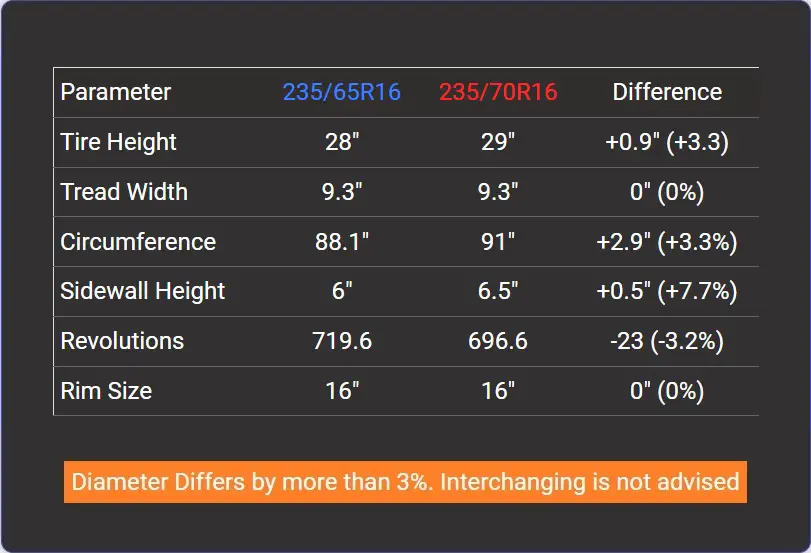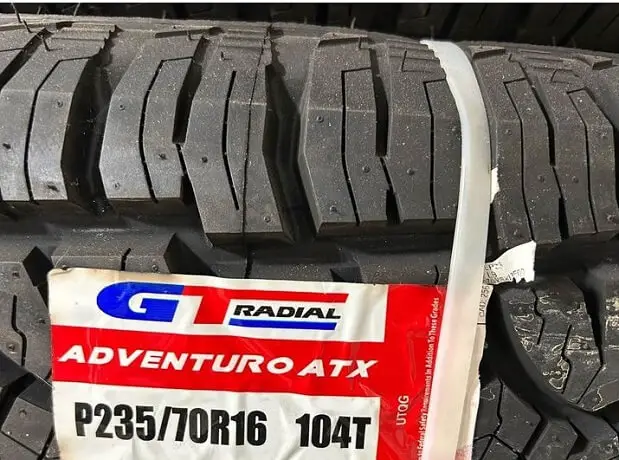Tire Size 235/65r16 vs 235/70r16

Switching from 235/65R16 to 235/70R16 tires involves a slight increase in overall diameter and sidewall height. This change impacts various aspects of your vehicle’s performance, both on and off-road.
While the difference is relatively small, it’s important to understand how it affects your driving experience and vehicle characteristics. Let’s explore the key implications of this tire switch.
- The overall diameter increases by 3.3%, just exceeding the recommended 3% limit.
- Sidewall height grows by 7.7%, potentially improving ride comfort.
- Ground clearance increases slightly, which may benefit off-road performance.
- Speedometer accuracy is affected, showing a lower speed than actual.
- Fuel efficiency might decrease marginally due to increased rolling resistance.

Fitment Guide
The diameter difference between 235/65R16 and 235/70R16 tires is 3.3%, slightly exceeding the recommended 3% range.
While this interchange is not strictly recommended, it’s close enough that many vehicles can accommodate the change without significant issues. However, it’s crucial to consider potential adaptations to prevent rubbing or clearance problems.

On-Road Impact
Switching to 235/70R16 tires affects various aspects of your vehicle’s on-road performance. From subtle changes in handling to noticeable differences in ride comfort, let’s explore how this tire switch impacts your daily driving experience.
- Ground Clearance: The 0.93-inch increase in diameter translates to about a 0.46-inch gain in ground clearance. On-road, this slight elevation may not be noticeable in everyday driving but could provide a marginal benefit when navigating speed bumps or small obstacles.
- Gas Mileage: The larger tire size may lead to a slight decrease in fuel efficiency due to increased rolling resistance and weight. However, the difference is likely to be minimal and may not be noticeable in day-to-day driving.
- Aesthetics: The taller sidewall of the 235/70R16 tire can give your vehicle a slightly more robust appearance. This change might be appealing if you prefer a beefier look for your vehicle.
- Ride Comfort: With an additional 0.46 inches of sidewall height, the 235/70R16 tires may offer improved ride comfort. The extra rubber can better absorb road imperfections, potentially resulting in a smoother ride, especially on rough roads.
- Speedometer Accuracy: The larger tire diameter affects your speedometer readings. At an indicated speed of 20 mph, your actual speed will be about 20.66 mph. This discrepancy increases at higher speeds, so it’s important to be aware of this when driving, especially in speed-sensitive areas.
- Durability & Wear: The taller sidewall of the 235/70R16 tire might offer slightly better protection against impacts with curbs or potholes. However, the overall effect on tire longevity is likely to be negligible.

Off-Road Impact
For those who enjoy venturing off the beaten path, the switch to 235/70R16 tires brings some interesting changes to your vehicle’s off-road capabilities. Let’s examine how this tire upgrade affects your off-road adventures.
- Ground Clearance: The increased ground clearance becomes more significant in off-road scenarios. An extra 0.46 inches can make a difference when navigating over rocks, logs, or uneven terrain, potentially reducing the risk of underbody damage.
- Traction: The larger overall diameter of the 235/70R16 tire means a slightly larger contact patch with the ground. This could provide a marginal improvement in traction, especially in loose or soft off-road conditions.
- Obstacle Navigation: The taller tire profile can help in rolling over small obstacles more easily, which can be beneficial in mild off-road situations.
- Vehicle Stability: The increased sidewall height might introduce a bit more flex in the tire during aggressive off-road maneuvers. This could slightly affect vehicle stability in extreme conditions, but for most off-road enthusiasts, the difference would be minimal.

What is the Difference Between 235/65r16 and 235/70r16?
The main difference between 235/65R16 and 235/70R16 tires is their overall diameter and sidewall height. The 235/70R16 tire has a larger overall diameter, standing 0.93 inches (23.5 mm) taller than the 235/65R16.
This increase in diameter results from a taller sidewall, with the 235/70R16 having a sidewall height of 6.48 inches compared to the 6.01 inches of the 235/65R16.
This difference affects various aspects of the tire’s performance, including ground clearance, ride comfort, and speedometer accuracy.
Can I use 235/65R16 instead of 235/70R16?
While it’s generally not recommended to use tires that differ in diameter by more than 3% compared to the original tires, the difference between 235/65R16 and 235/70R16 is right at the borderline.
The diameter difference is 3.3%, which slightly exceeds the recommended 3% limit. This means that while it may be possible to use 235/65R16 instead of 235/70R16.
It’s not ideal and could potentially affect vehicle handling, speedometer accuracy, and overall performance. It’s advisable to consult with a tire professional or your vehicle manufacturer before making this switch.
How Much Taller Is A 235/70R16 Tire Than A 235/65R16?
Based on the provided data, a 235/70R16 tire is 0.93 inches (23.5 mm) taller than a 235/65R16 tire.
The 235/65R16 tire has a diameter of 28.03 inches (711.9 mm), while the 235/70R16 tire has a diameter of 28.95 inches (735.4 mm).
How Much Wider is a 235/65r16 Tire Than a 235/70r16?
There is no difference in width between a 235/65R16 tire and a 235/70R16 tire. Both tires have a width of 9.25 inches (235 mm).
The difference in these tire sizes is in their aspect ratio (65 vs. 70), which affects the sidewall height and overall diameter, not the width.
Our Observation
Switching from 235/65R16 to 235/70R16 tires offers a mix of benefits and minor drawbacks. The increased ground clearance and potentially improved ride comfort are notable advantages, especially for those who occasionally venture off-road.
However, the slight decrease in fuel efficiency and speedometer inaccuracy are factors to consider. For on-road use, the differences in performance and handling are likely to be negligible for most drivers.
Off-road, the benefits become more apparent, with improved obstacle clearance and potentially better traction in challenging conditions.
Overall, while this tire switch exceeds the recommended 3% diameter change, its effects are relatively minor and may be acceptable for many vehicles and driving styles.

Meet Caitlin McCormack, a Tire Size Expert and Blogger Passionate About Everything Related to Tires. With Years of Experience in the Tire Industry, Caitlin Has Become an Expert in Tire Sizes and Their Impact on Vehicle Performance.
